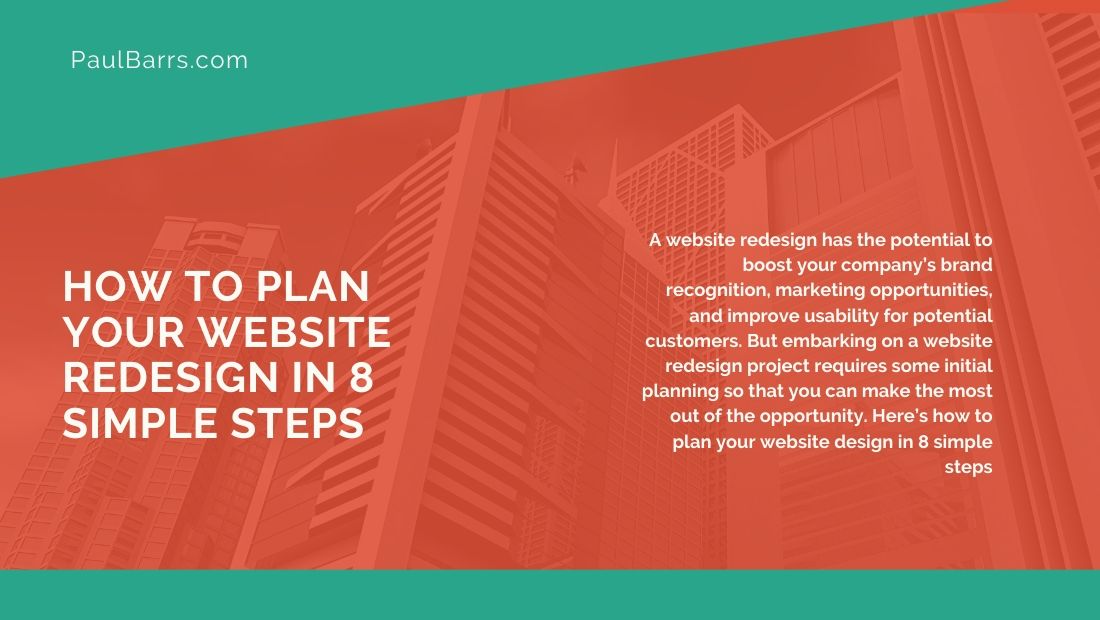
21 Oct How To Plan Your Website ReDesign in 8 Simple Steps
A website redesign has the potential to boost your company’s brand recognition, and marketing opportunities, and improve usability for potential customers. But embarking on a website redesign project requires some initial planning so that you can make the most out of the opportunity. Here’s how to plan your website design in 8 simple steps.
- Navigate Your Existing Site
Understanding what’s on your existing site is the first step in building a plan for a successful redesign. Go through each page on a laptop, mobile, and tablet and establish whether it’s challenging to navigate, and which portions of the site aren’t supported on specific devices. You might find information on the site that needs updating, graphics that look tired, or realize that overall the website design doesn’t reflect your company.
- Manage Your Analytics
Compiling a list of your crucial analytics will give you an accurate assessment of the landscape of your site. Which areas are drawing the viewer in, and which ones are less successful? Items to consider include:
- Monthly bounce rate, conversion rate and SEO rankings by keyword
- Average website visits, time on a page, and traffic per page per month
- Inbound links by domain
- The average amount of leads and sales per month
- Consider The Design
Is your current design well laid out, and is it easy for the user to navigate? Ensuring your website design is functional is the best way to make it easy for your potential customer to navigate and up your conversion rate. Although it should be a case of substance over style, the layout and use of graphics on the site should be easy to view and be an accurate reflection of your branding. Is the style consistent across your pages?
- Set Realistic Goals That Align With Your Customers
Once you’ve got an accurate picture of your conversion rates and less successful pages, you can set some clear goals for what you’re trying to achieve with your site. At every step of the process, consider your customer, and you could ask some of the following questions:
- What pages are my customers currently interacting with, and why?
- Which pieces of information do I think my customer would like to know?
- What is the easiest way for customers to access this critical information?
Once you’ve done this, aligning them into achievable goals like using the website design to increase sales, improving client retention, and also making the website a more user-friendly experience will help you determine what the goals of the redesign are.
- Consider Your Content
Now you know which keywords are ranking highest and which pages are attracting higher or lower volumes of traffic, you can start to review your existing content and make it work for you. Having a rough idea of the design will also be very useful as you might need to increase or decrease the volume of content on the page, while also ensuring SEO optimization and maintaining essential information for the customer.
- Are The Content And Design Consistent With Your Branding
As you embark on your web design, continually coming back to your company brand and rechecking that everything new you’re doing is consistent, will help keep the site coherent and in line with the company values overall. Doing this regularly will stop you from going down a path that isn’t in line with your actual organization.
- Create A Site Map
Looking at the big picture, like how you want the user to navigate from page to page can be done by creating a site map. Visualizing how you want your customers to navigate will ensure you don’t miss a vital step that will ultimately undo all your redesign plans. Looking at making the sales cycle as straightforward as possible with minimal click-throughs will help lead conversion too.
- Partner With A Web Design Professional
You might have an exact idea of what you want your website design to look like, but lack the technical expertise to execute your vision. You may also be struggling to pin down what needs changing or how to improve your current site. Partnering with a professional like Paul Barrs will help you, as after an initial consultation to determine your goals, they can create a first draft for you to check and make sure it is precisely what you expected.
Planning your redesign doesn’t have to be stressful and can present you with the perfect opportunity to give your website a new lease of life. Contact Paul Barrs today for more help on your website redesign.


